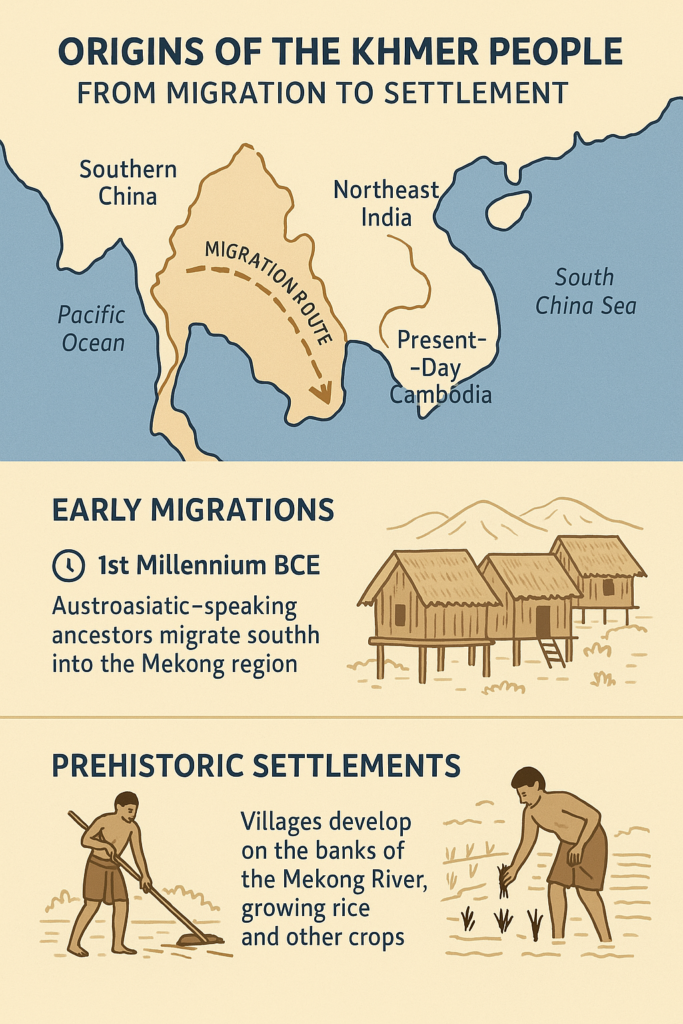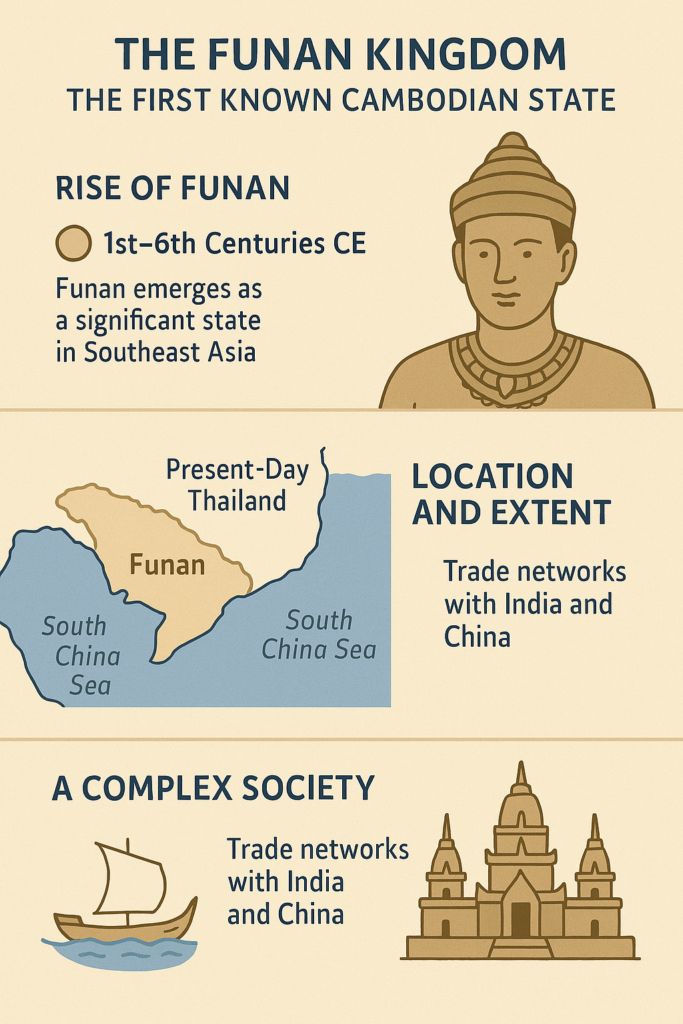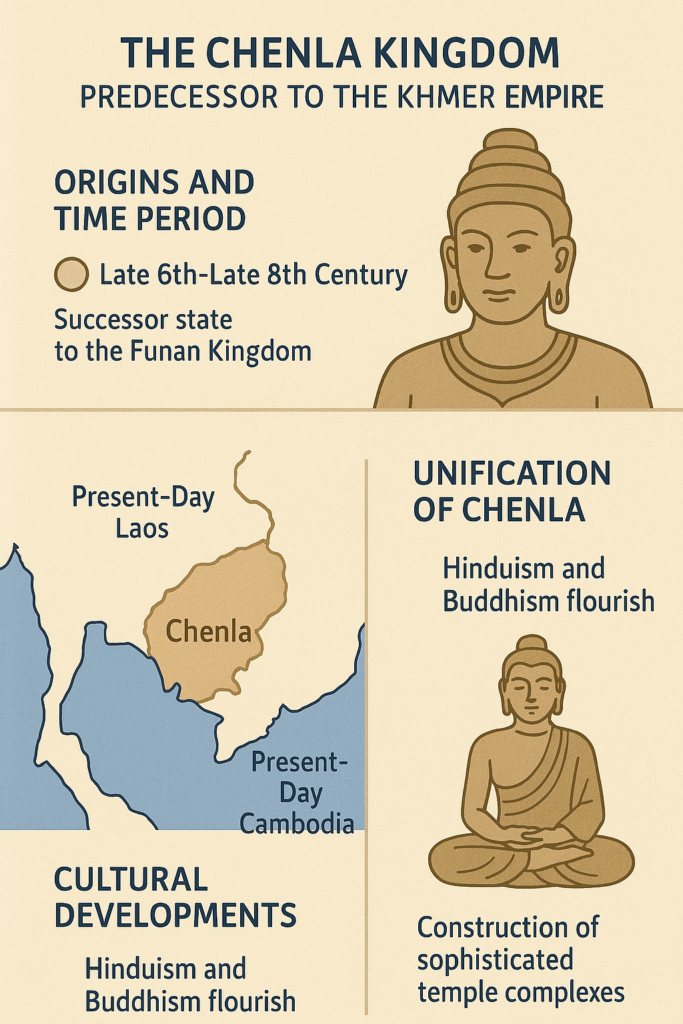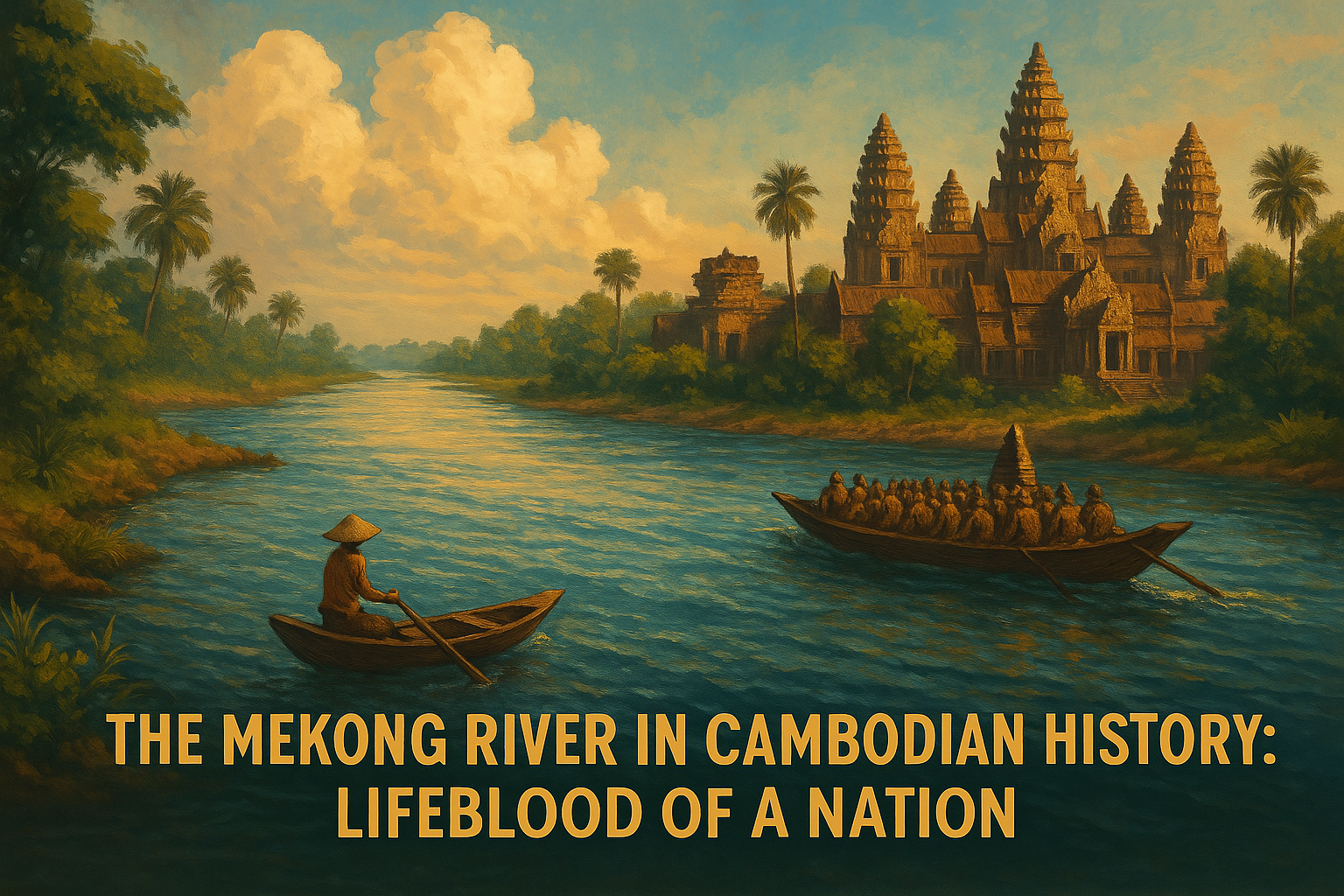
Cambodia’s rich cultural heritage is rooted in the ancient Khmer civilization—one of the most remarkable and enduring civilizations in Southeast Asian history. Before the majestic temples of Angkor rose from the forests, the Khmer people had already laid down the foundations of a sophisticated society marked by political innovation, cultural synthesis, and agricultural mastery.
In this article, we explore the origins and evolution of ancient Khmer civilization—tracing the early migrations of the Khmer people, the rise of Funan and Chenla, the influence of trade with India and China, the birth of Khmer script, and the critical role of irrigation and agriculture in shaping Khmer society.
Origins of the Khmer People and Early Migrations

The Khmer people are part of the larger Austroasiatic language family, which includes groups spread across mainland Southeast Asia and parts of India. Linguistic and archaeological evidence suggests that the ancestors of the Khmer migrated into the region of present-day Cambodia thousands of years ago, possibly from southern China or northeast India.
By the early first millennium BCE, these communities had settled in the fertile floodplains of the Mekong River, forming small agricultural villages. Over time, these settlements evolved into more complex chiefdoms, driven by population growth, increased rice production, and local trade. These early Khmer groups had no writing system, but they developed a shared culture rooted in animist beliefs, ancestor worship, and a deep relationship with the land and water.
The Funan Kingdom: The First Known Cambodian State

Funan is considered the first known kingdom of the Khmer people, emerging around the 1st century CE and flourishing until the 6th century. Although its original name is lost to history, “Funan” is a Chinese transliteration, as most of what we know about this kingdom comes from Chinese historical records.
Funan was centered in the lower Mekong Delta, a strategic region that allowed it to control trade routes between India and China. According to legend, the kingdom was founded by an Indian Brahmin named Kaundinya, who married a local Naga princess, Soma—symbolizing the fusion of Indian and indigenous traditions that would shape Khmer culture for centuries.
Funan was a maritime trading powerhouse. Goods like spices, precious stones, ivory, and textiles flowed through its ports. It adopted many aspects of Indian culture, including Hinduism, Buddhism, the Sanskrit language, and Indian art styles, creating a uniquely Khmer-Indian synthesis.
The Chenla Kingdom: Predecessor to the Khmer Empire

By the 6th century CE, Funan began to decline, and the kingdom of Chenla rose to prominence. Chenla was more inland-based than Funan, occupying areas of present-day northern Cambodia and southern Laos.
Unlike the seafaring Funan, Chenla emphasized territorial expansion and agricultural development. It was originally a vassal of Funan but eventually overthrew its predecessor. Chenla is often divided by historians into two phases: Early Chenla (pre-8th century) and Late Chenla (post-8th century), the latter marked by internal divisions and foreign invasions.
Chenla saw the rise of monumental temple-building using brick and sandstone, laying the groundwork for the architectural mastery of the Khmer Empire. Kings of Chenla continued to adopt and adapt Indian religious and political models but also began to integrate more distinctly Khmer elements into their art, language, and governance.
Trade and Cultural Exchanges with India and China

From the earliest periods, the Khmer region was at the crossroads of major trade routes. This position facilitated profound cultural exchanges with two major civilizations—India and China.
From India came religion, writing systems, political theories, and artistic styles. Indian Brahmins introduced Hindu cosmology and the concept of divine kingship, or devaraja, which would become central to Khmer rulership. Buddhism also spread through Indian monks and merchants, influencing both elite and popular religious practices.
Chinese records provide valuable historical information about the early Khmer kingdoms. Chinese envoys and traders interacted with the courts of Funan and Chenla, describing the customs, wealth, and governance of these lands. Khmer rulers also sent diplomatic missions to Chinese emperors, seeking prestige and favorable trade relations.
Through these interactions, Khmer culture became a rich blend of local traditions and foreign influences, shaping a distinct Southeast Asian identity with universal appeal.
The Development of Khmer Script and Early Writing

A major milestone in Khmer civilization was the development of a writing system. The earliest known Khmer inscriptions date to the 7th century CE and were heavily influenced by the Pallava script of southern India.
These early inscriptions were written in both Sanskrit and Old Khmer. Sanskrit was used for religious texts and royal proclamations, while Old Khmer was used for administrative and practical purposes. Over time, Khmer evolved its own script, which remains in use today—one of the oldest continuous scripts in Southeast Asia.
These inscriptions, etched in stone, offer invaluable insights into ancient Khmer society, recording royal lineages, temple dedications, land grants, and religious beliefs. They show a society that was literate, hierarchical, and deeply spiritual, with a ruling class that saw itself as divinely ordained.
The Role of Irrigation and Agriculture in Early Khmer Society

The backbone of early Khmer civilization was its agricultural economy, particularly wet-rice cultivation. The Khmer people developed advanced irrigation systems to harness the seasonal rains and the mighty Mekong and Tonle Sap rivers.
These systems included canals, reservoirs (barays), dikes, and moats. By regulating water flow, Khmer farmers could produce multiple rice harvests per year—a revolutionary achievement that supported urban growth, population expansion, and political centralization.
The importance of irrigation extended beyond economics. It reflected the Khmer worldview, where kings were not only political leaders but also divine protectors who maintained harmony between heaven and earth. Building and maintaining irrigation systems was a sacred duty, and rulers gained legitimacy by demonstrating their ability to provide agricultural abundance.
Conclusion: The Foundations of a Great Empire
The ancient Khmer civilization was no mere prelude to Angkor—it was a sophisticated world in its own right, defined by dynamic kingdoms, cross-cultural exchanges, intellectual development, and engineering prowess. From the maritime empire of Funan to the inland expansion of Chenla, the early Khmer laid the foundations for what would become one of Asia’s greatest empires.
Understanding these roots not only deepens our appreciation for Cambodia’s past but also reveals the enduring spirit of a people whose identity continues to be shaped by their ancient legacy.





